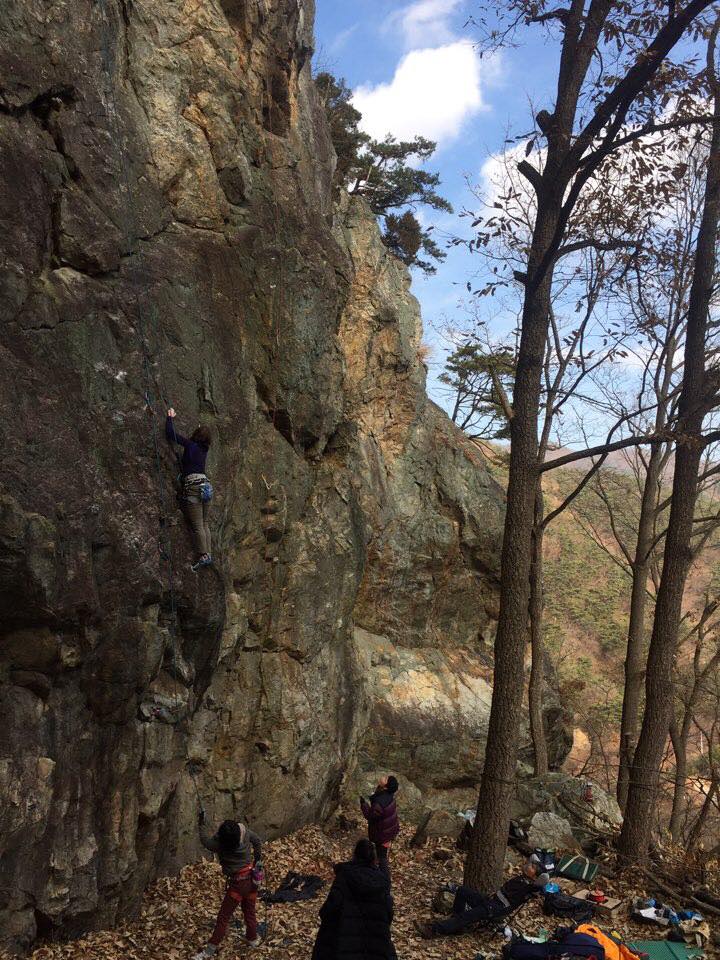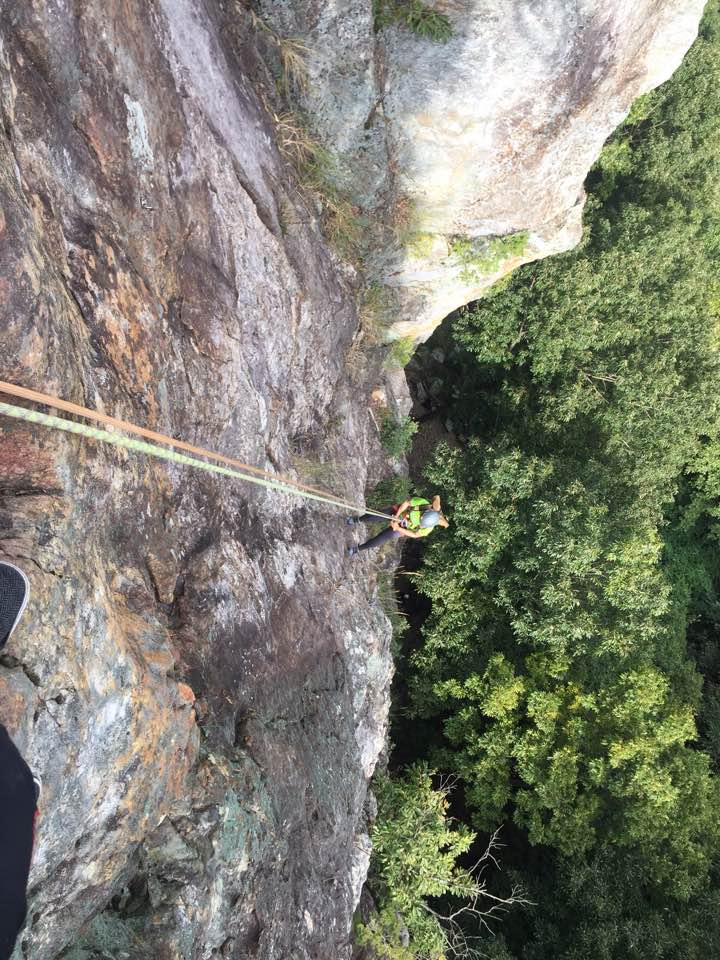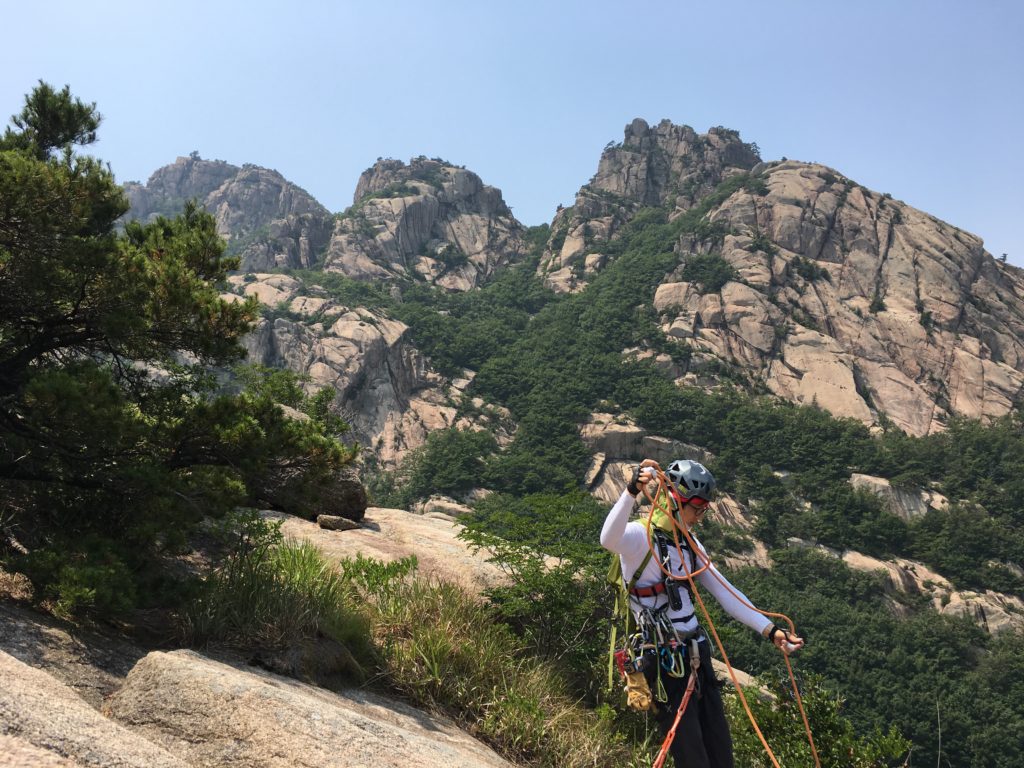Organized Climb
Written by William Urbanski
A salient and unifying characteristic of the human species is the overwhelming compulsion to scale a mountain with one’s bare hands that comes with watching Sylvester Stallone’s 1993 classic Cliffhanger. For eons, mankind has worshipped, revered, and at times even despised these rocky goliaths we call mountains. But is there anyone in Gwangju who sufficiently embodies the renegade spirit to conquer these behemoths?
Climbing Gyms: Portals into the Universe of Climbing
For most people, their first real contact with climbing as a sport comes through an indoor climbing gym, many of which have been featured in previous issues of the Gwangju News. The artificial walls inside these gyms have a pre-fastened top rope as well as rock holds and do a good job of balancing the thrill of climbing with the feeling of safety that comes from organization, instruction, and direct supervision. Bouldering, which tests a climber’s ability to navigate inverted slopes, albeit closer to the ground while eschewing ropes and gear, has become a particularly popular and ubiquitous feature of climbing gyms. While indoor gyms are really fun and offer direct and easy access to climbing, just as taking a dip in a heated pool is a far cry from swimming in an ocean, a fuller, more authentic climbing experience awaits those who venture outdoors.

The Outdoor Difference
Gwangju denizens and climbers Emily Johnson and Tim Han explained to me that, more than ends in and of themselves, indoor climbing walls were created by outdoor climbers who wanted to keep their skills fresh when outdoor climbing was not feasible. So, while indoor climbing offers a “one-stop shop” approach to climbing, this convenience is also a limitation, which by definition excludes elements of risk, danger, and unpredictability that make climbing exciting. Emily explained, “Climbing outdoors is not for everyone, but being one with nature and overcoming physical and mental hurdles outdoors is beyond comparison with indoor climbing.”

For those who have honed their climbing skills in a gym, equipment and location are the major considerations before heading outdoors. Tim explained that the most essential piece of gear is a harness that can run around 45,000 won. While experienced climbers have their own ropes, quickdraws, belay devices, and chalk bags, most of these can usually be borrowed. The other major consideration is where to go. There are various spots around Jeollanam-do, even at Mudeung Mountain
(무등산), all with various levels of difficulty. “Many of the good climbing spots are off the beaten path,” said Emily, so it is usually best to connect with someone who knows a few spots ahead of time. Climbing routes are generally graded according to difficulty, but the grades are somewhat subjective and usually only give a rough indication of how hard a cliff is to ascend.
Outdoor rock faces often necessitate “lead climbing,” which is when a climber is responsible for securing themselves in incremental stages while someone on the ground holds a rope, connecting the climber to the last hook that they have reached. This is definitely a more involved, active approach to climbing. While most people have etched into their minds the image of having to hammer hooks into the rock face, in reality, the routes are usually pre-set with existing hooks, or in climbing parlance, “bolted.” Therefore, no hammering is required, but there will be pre-determined routes. Emily said that it is actually taboo to change the route that someone has created. Bolting a cliff, meaning being the first person to insert the necessary hooks, is an ordeal which needs not concern the novice climber. “It usually involves rappelling down a cliff after carefully considering the climbing sequences,” Tim explained.

Besides the obvious indoor–outdoor dichotomy, the number one advantage of experiencing climbing out of the gym is the scope and breadth of opportunities that await climbers. Outdoor climbing goes hand in hand with exploration and international travel. Emily and Tim have incorporated climbing into their trips to Thailand, Laos, and Vietnam, as well as to various places around Korea.
Getting Suited and Booted
Emily and Tim both agreed that the best way to get involved in outdoor climbing is through one of the climbing gyms around Gwangju. To locate one close to you, follow the links on www.climbinginkorea.blogspot.com. The gyms can connect you with other climbers, offer classes in the various styles of climbing, and in many cases, even offer day trips that provide the gear and transportation to natural spots. A further resource that is a virtual cornucopia of climbing information is www.koreaontherocks.com.
While most of us will never reach the climbing prowess of Stallone or Tom Cruise in his stunning free solo at the beginning of 2000’s Mission: Impossible 2, trying outdoor climbing will help you reach your own “Vertical Limit.” It is what Stallone would want.
Photographs by Emily Johnson and Tim Han
The Author
William Urbanski is from Canada and has lived in Korea for about seven years. He’s married to a wonderful Korean woman and can eat spicy food.




